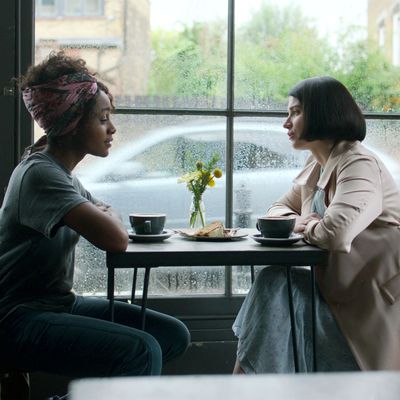
Behind Her Eyes, the new Netflix series based on the novel by Sarah Pinborough, is a psychological adultery thriller about a woman having an affair with her married boss. It’s also about addiction, lucid dreaming, British classism, lies, and trauma. Mostly, though, Behind Her Eyes is a series about its ending. The pieces are set up with straightforward clarity. Simona Brown is the protagonist Louise; Tom Bateman is her boss David; Eve Hewson plays David’s wife, Adele; and Robert Aramayo plays Adele’s friend Rob, who’s seen in flashbacks to Adele’s mysterious past. Once that’s all in place, though, Behind Her Eyes surges inexorably toward its big thriller ending, which is so twisty and strange that it obliterates any other impression Behind Her Eyes might’ve left.
That massive black hole of a final episode explains a lot about how the rest of Behind Her Eyes comes off. Its first episodes are oddly hollow. Louise, a Black woman with a young son and a nice-but-distant ex-husband, has few distinctive qualities. She’s a smooth surface, gliding into the grooves Behind Her Eyes has created for her. Here’s Louise going to work, here’s Louise being a nice mom to her kid, and here’s Louise being lonely in a cookie-cutter, have-a-glass-of-wine-after-bedtime sort of way. She meets David, she’s drawn to him, she eventually realizes that David’s hidden a lot of his life from her, and then Louise gets drawn into a tense, secretive psychosexual relationship with David and Adele.
Occasionally the series loops back to flashbacks of Adele’s youth, where we meet Rob and learn more about Adele’s tragic backstory. Often, the show is punctuated by surrealist dream sequences, where various members of this cursed, interlocking triad have trippy and disruptive dreams, more like hallucinations than garden-variety nightmares. But always, there’s a sense that Behind Her Eyes is fundamentally shallow. It’s not particularly invested in who Louise or David are, and it’s not all that interested in Rob either. The show’s primary focus is on Adele, who swings between mistreated wife and dangerous monster depending on which secrets have most recently been revealed. Even for Adele, though, the core quality is still that she’s an enigma. It’s like a drama being played out with figures shaped and then pushed into the right sequence of moves just to see if the whole thing could work, and work here is defined as “can carry the whole thing well enough until it gets to the end.”
Seeing the end does help explain the shallowness and heady ungrounded slickness of the previous five episodes. The empty characterization isn’t egregious, but it seems like an apparatus that’s been built around some hidden central engine the show doesn’t want to reveal. Why are these people like this? What’s with all the trippy dreams? Who am I supposed to care about right now? The end illuminates all of that. It’s not that suddenly everything makes sense, or that the characters click into place in a way they hadn’t before. (In fact, the ending has a fantastic commitment to not making any sense whatsoever.) Instead, reaching the final moments of the last episode is like seeing the curtain pulled back to reveal what it was all for. It was all for this, this unbelievably wild and goofy last twist, a nuclear reactor of an ending that can only exist to give people a physical response of shock and dismay.
It’s an ending that’s so unmistakably absurd that it feels like being trolled. If the characters were richer, or if the slow burn of the first several episodes of the show were more absorbing, it’d be easier to argue that the ending is an exciting escalation, or maybe a polarizing capper to a previously enjoyable thriller. But the end is very obviously the whole game. There is no animating energy here beyond luring the audience toward those last several minutes.
It’s a jack-in-the-box show, and to be fair, Behind Her Eyes is hardly disguising that aim. Each new development is a new turn of the handle, and all the aesthetic signals — the flashbacks, the music, the creepy cinematography — add up to that overall sense of the jack-in-the-box’s music slowing down. You know the pop of surprise is coming. Except instead of a puppet jumping out of the box, someone runs in at the last moment and dumps a tub of jello over your shoulders. Sure, it’s a shocking experience. It’s also a totally different kind of shock from what you were led to expect, it’s a tiny bit cruel, and it’s extremely, extremely weird.
This is not an attempt to write off the experience of Behind Her Eyes entirely. Sometimes it’s pleasurable to go into a story knowing that the end will be a big, disorienting, trollish wallop. I haven’t read the book the series is based on, but it was marketed with the hashtag #WTFEnding, which only further emphasizes the trolling element of the entire exercise. You enter into it knowing the aim is a conclusion so notable that you can hang a marketing hashtag on its merits. If that’s an exciting prospect, then Behind Her Eyes is waiting for you, ready to take you by surprise.


